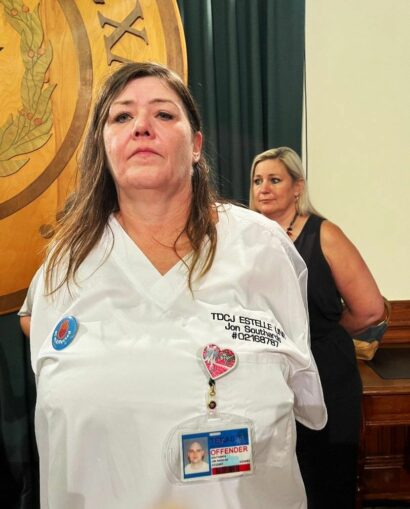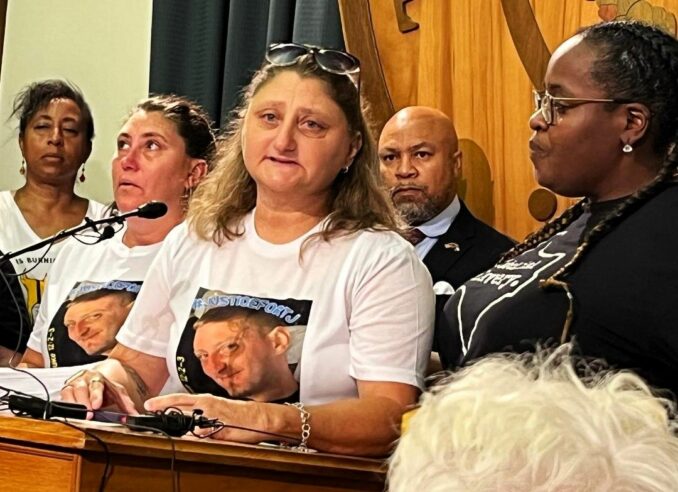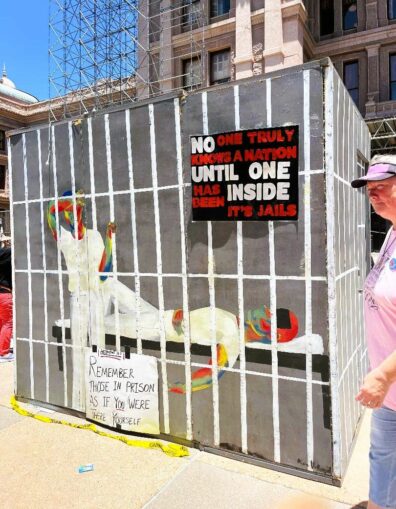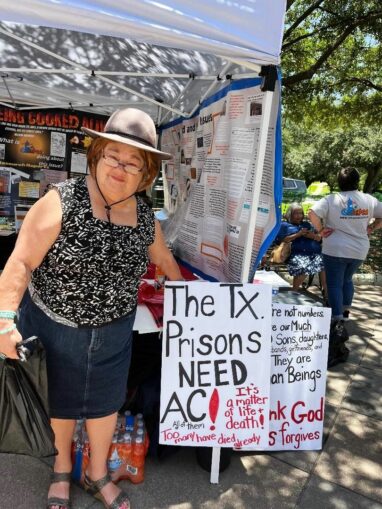“They’re killing us in here!”
Houston
Tona Southards Naranjo told a stunned crowd at a press conference July 18 in Austin at the Texas state Capitol: “He was my only child. Jon Anthony Southards was a loving son. Texas murdered him in the heat. We need desperate change. And we need it today, this hour, before the sun sets on our brow this day, ladies and gentlemen, we need respite care in the Texas Department of Criminal Justice.

Tona Southards Naranjo wearing her dead son’s prison uniform shirt. (WW photo: Gloria Rubac)
“They’re cooking our babies alive. When? Now. Right. I’m mad. Yeah. I’m a grieving mother. The death of my son makes me angry,” said Naranjo, wearing her son’s white prison uniform shirt with his name on it; his prison ID was clipped on it.
Prison cells reach 150 degrees
The press conference was an emotional gathering where families whose loved ones have died in the prison heat spoke, cried, pleaded and begged for Texas to stop the killing. It began a day of activism called “85 to Survive,” referring to the highest temperature allowed by law in city and county jails. But the state prisons had no boundaries on temperatures. It has been documented that they have gone as high as 150 degrees in Texas prison cells.

Kristie Williams describes death of her brother T.J. (WW photo: Gloria Rubac)
“The resources are there,” said Kristie Williams. “You that are elected need to be responsible for making certain that the living conditions are above that of animal shelters for these inmates.” Williams’ brother T.J. died while working outside of his prison. She tried to raise enough to bury him, but only raised enough for a cremation. She and an aunt were going to pick up the ashes after the rally.
Marci Marie Simmons told the media she spent 10 years in prison. “I worked on the hoe squad in the fields. It’s very much like plantation work. We worked all summer in the heat, in triple digit weather. When we were going back inside after our three-second water break, we were dreading going into our dorms. As hot and miserable as it was outside, it was 15 or 20 degrees hotter in our cells.’
A matter of life and death
Marie continued: “I remember we got one egg that was smuggled in by a kitchen cook. We put it on our dorm floor and cracked it and watched it fry on the floor. I remember thinking, ‘What is this heat doing to the inside of my body? I was one of the lucky ones as I was 30 years old and healthy. I watched the older ladies around me who had health problems and they weren’t okay. They were falling out. Heat was causing seizures, three or four a day. Ambulances were coming all week. We’re talking about life and death today.”
Organizers held up stacks of letters they had received from incarcerated people describing the conditions they were trying to survive. One letter read: “My son is in Beto Unit and it’s so hot that people are passing out. They are not giving us ice or water.” Another said: “It’s 134 degrees at the Vance Unit today. We sleep on the concrete floor in puddles of water. We wake up when it evaporates and flood the floor again.” Copies of letters were delivered to the offices of lawmakers in the Capitol.
One mother was in tears because she said her daughter only had eight more months to finish her prison sentence. “My daughter said she didn’t think she would live to the end of the summer. She says she can’t breathe. That there is no air in her cell. I can’t stand to think of her dying. She wasn’t sentenced to die,” she told Workers World. She didn’t want her name used, fearing her daughter would be retaliated against.
Thought-provoking mock cell

(WW photo: Gloria Rubac)
Then there was a rally outside where activists and families spoke. It was 106 degrees that afternoon as hundreds gathered to listen to speakers on the Capitol’s south steps, browse booths set up by organizations, sign petitions and buy T-whirts.
Disgust was voiced regarding the statements repeatedly made by prison authorities’ spokespeople – that not all people in Texas have air conditioning and prisoners just needed to make adjustments like the general population does. According to the U.S. Energy Information Administration in Washington, D.C., nearly 90% of U.S. housing uses air conditioning. In Texas, the number is closer to 93%. Plus, “free-world” people can take showers, drink cool water and go to cooling centers or malls or libraries to spend their days.
Outside the Capitol, the Texas Prison Community Advocates set up a model cell that people could enter to experience the heat. The thought-provoking mock cell exhibit was over 100 degrees inside. It was recommended that people stay inside it for seven minutes.
As outraged people left the Capitol, it was reported that the Texas Department of Criminal Justice (TDCJ) had just doubled the price of water available to incarcerated people in the prison commissaries! A bottle that had sold for 15 cents is now 30 cents. Bottles of orange juice that had been 65 cents are now $1.20.

Angie Agapetus, leader of the Texas Death Penalty Abolition Movement. (WW photo: Gloria Rubac)
After leaving the Austin event, Angie Agapetus, a leader of the Texas Death Penalty Abolition Movement, commented: “It seems that going to prison in Texas can be a death sentence for anyone. The heat is only going to get worse, and Texas must address this issue immediately. Air conditioning is not a luxury but a necessity. The deaths are murder and activists will fight until we stop them,”
The Texas Death Penalty Abolition Movement plans to have speakers at the August 25 meeting of the Texas Board of Criminal Justice which governs the whole prison system. They will also protest outside of the meeting regarding the death by heat as well as the unconscionable price gouging in the commissaries.

